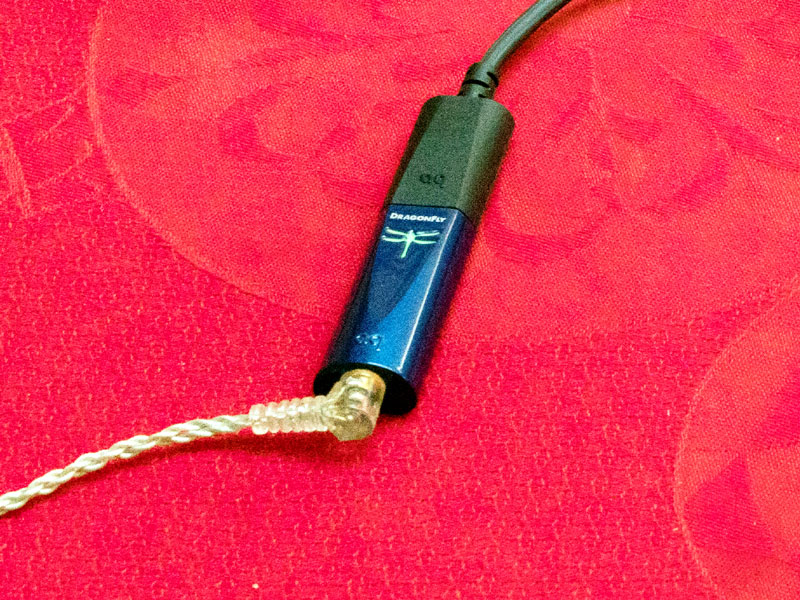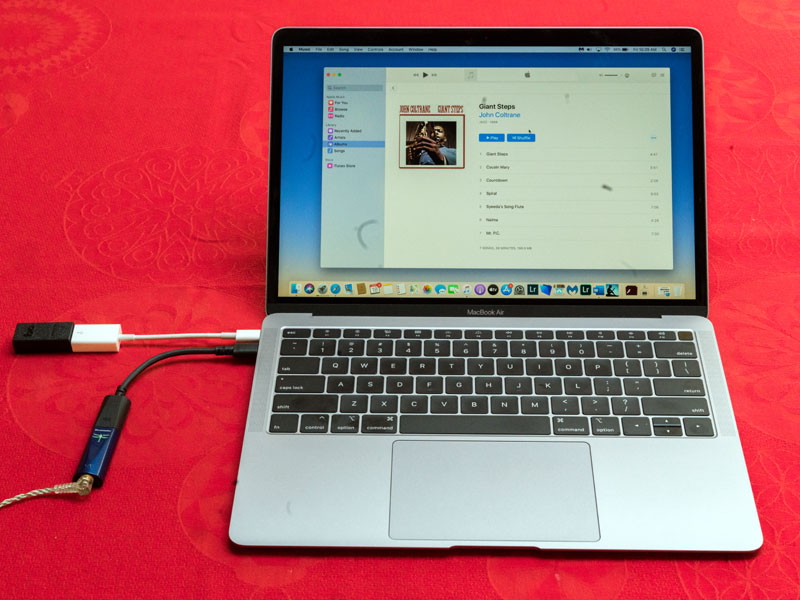First Sounds: AudioQuest DragonFly Cobalt
few years back, I surveyed several options for listening to music on the go, comparing AudioQuest’s DragonFly Red with several other more powerful portable DAC/amplifier combinations. Three years on, I still regularly use and enjoy the DragonFly Red, while the other products have fallen to the roadside. Situated between an iPhone and a pair of in-ear monitors, the Red has proved to be a world-beater, and I can’t think of a single audio product I’ve owned that gives so much enjoyment for so little money -- a mere $200. With the introduction of the DragonFly Cobalt, AudioQuest now has a DragonFly for every (low) budget -- the $100 Black, the $200 Red and the $300 Cobalt. Although I admire the blue finish of the new Cobalt, I love the candy-apple red finish of the Red. Notwithstanding my color preference, as good as the still-available Red is (and it is very good), the Cobalt is even better. The Cobalt uses the ESS ES9038Q2M DAC chip and a Microchip PIC32MX274 microcontroller. AudioQuest claims that the new DAC chip has a "minimum-phase roll-off filter" for more natural sound and that the new microprocessor draws less current and increases processing speed by a third over the one used in the Red. AudioQuest also claims that the Cobalt includes improved power-supply filtering that increases immunity to WiFi, Bluetooth and cellular noise. The Cobalt uses the same ESS Sabre 9601 headphone-amplifier chip as in the Red. Like all of the DragonFlys, the Cobalt is compatible with Apple and Windows PCs and renders MQA. Like the Black and Red, the Cobalt does high-res PCM up to 24 bits and 96kHz sampling frequency. If you are wedded to rates higher than this limitation (I’m not unless its analog!), look elsewhere for heavier and far more expensive DACs.
Visually, the Cobalt is a wee bit smaller than the Red and weighs in a little lighter, so depending how you think of it, the Cobalt is either more pocket-friendly or easier to lose. The more significant visual difference, when you open the box, is that the Cobalt package includes what AudioQuest calls a DragonTail USB-C adapter. The DragonTail allows you to plug directly into Apple devices larger than an iPhone (which requires a Lightning USB adapter, known in AppleSpeak as a “USB camera adapter”). The AudioQuest version of the USB-C adapter is about half an inch longer than the Apple version, and, of course, it uses AudioQuest wire as opposed to “Apple” wire. Additionally, even if you already have an Apple USB-C adapter, this second USB-C adapter comes in handy for those wanting to add an AudioQuest JitterBug USB filter into the mix, allowing you to hang the JitterBug off a separate computer output from that used for your DragonFly (AudioQuest does not recommend using them in series). In keeping with the Cobalt's minimalist size and styling, there are no physical buttons or other controls. Such controls as exist are adjusted through the host computer device. The Cobalt has an LED (in the shape of a dragonfly) that changes color depending on the sampling rate being processed. Although some applications, such as Roon, automatically set the DragonFly’s sampling rate, you otherwise need to set your computer’s audio MIDI setup (Mac OS) or sound control panel (Windows) to allow for sampling rates higher than 44.1kHz. Although the Cobalt has a 64-position volume control, it is operated through the host computer’s volume control. Other than that, it’s as simple as plug and play. I used the Cobalt with a variety of combinations -- as a DAC driving my main system for listening to streamed music; with everything from full-on headphones, to noise-cancelling headphones and with in-ear monitors; through desktop, laptop and iPhone use. Source material was streamed content (Qobuz and Tidal partner with AudioQuest in offering free trials with your purchase) and downloaded high-resolution samples, but by far I spent the most time listening to CDs ripped to iTunes (now called Music) via my iPhone and MacBook Air -- music I’ve heard many times and, in most cases, in different formats. I began listening with gear that's a natural partner for the DragonFly Cobalt -- gear that by audiophile standards is ultra-compact. Using an iPhone as a source, I plugged Apple’s Lightning-to-USB camera adapter ($29) into the phone. Alternatively, I used a MacBook Air or other portable device with a USB 3 port and plugged in the included DragonTail USB extender into the Cobalt. Either way, my favorite way of enjoying the Cobalt was to hang a pair of Ultimate Ears UE 18 Pro in-ear monitors off it. After all, the DragonFly Cobalt clearly aims to achieve ultimate portability, so taking it to the limit is not only called for but almost demanded. Why scale back your DAC/headphone amplifier to the size of a USB stick and listen only with full-size headphones? And as discussed below, the Cobalt performed beautifully in my full-on system, but why make a home component so small that it could accidently drop into the pocket of a careless houseguest? No, the real challenge is to scale back a system, where the source component fits unobtrusively into your shirt pocket, connected by ultra-flexible cable to your earphones, allowing you to strut about the house wearing your entire stereo system, the most visible part of which are in-ear monitors sculpted to be barely visible in your ear canals, allowing you to imagine yourself stepping to the stage microphone as Lady Gaga or Pete Townshend. But it’s not just the scale of the system that matters -- the scale of the musical image is even more important. The DragonFly Red performed well in this area, and the Cobalt is its equal in presenting a large soundstage, or at least large in the context of headphone listening. Rather than collapsing everything inside your head, the DragonFly Cobalt creates an image that forms a large globe around your head. Even with a very large orchestral piece, like the Mahler Symphony No.6 (Claudio Abbado conducting the Berliner Philharmoniker [Deutsche Grammophon Gesellschaft 00289 477 5573]), which can challenge a concert stage in stuffing a lot of musicians into a limited space, the Cobalt displayed the orchestra comfortably spread out so that the sections of the orchestra did not bleed one into another. Like the Red, the Cobalt produced very respectful bass and dynamics, with the giant hammer blows in the fourth movement deep and sudden. By the second movement of the symphony, it had become apparent where the Cobalt’s performance exceeded that of its less-expensive sibling. The Cobalt’s midrange has warmth and presence suggesting a more robust device than a pocket-sized DAC. On the aforementioned Mahler, the all-important midrange took on a more three-dimensional aspect when switching from Red to Cobalt, which sounds much more like what I hear in the hall. Granted, it can also accentuate Deutsche Grammophon’s spotlighting of instruments like the harp that never stands out quite so much in real life. The differences are, if anything, even greater on recording of solo instruments or smaller ensembles. Patricia Kopatchinskaja’s violin tone on her new recording with Camerata Bern (Time & Eternity [Alpha 545]), reproduced through the Cobalt, sounded more like a bow vibrating violin strings and less like a digital reproduction of the same event. On well-recorded jazz material like The Jeremy Steig Quartet playing "Lover Man" from the CD reissue of Flute Fever [International Phonograph/Columbia CS 8936], the step up from Red to Cobalt imbued the piano with a richness not quite as apparent with the Red. The Red excelled in the areas of precision and clarity. The Cobalt gave up a shade of that precision and replaced it with a superior sense of structure and depth.
I inserted the Cobalt between my MacBook Air and Audio Research Reference 6 preamplifier via an inexpensive ($85) AudioQuest Golden Gate mini-to-RCA cable. Listening to streamed music in this way was a surprisingly positive experience. I normally listen to most of my streamed music at shows, where I’m not given a choice to do otherwise, but at home I stream music only occasionally from my computer as a default for want of what I’m looking for in my library of physical media. To paraphrase Doris Lessing, I refuse to commit the sin of persuading myself that second best is anything but second best. And on any streaming apparatus, streamed music is still second to what can be achieved with physical media. But with the Cobalt, I was surprised at how decent second-best sounded. Keep in mind that, accessories aside, there is not another component in my system costing less than ten times the price of a Cobalt. Streaming music from my MacBook Air library or from Qobuz produced sound as good or better than what I generally hear at shows with very expensive streaming devices.I tried running a parallel AudioQuest JitterBug with the Cobalt, finding improvement elusive with the addition. While I thought I could detect occasional differences, they were subtle. I also compared the amplification stage of the Cobalt with that of full-on headphone amplifier. Not surprisingly, the amplification stage of a portable Cobalt is no competition for a full-scale amplifier driving regular headphones, but the lighter touch of a fully portable rig seems entirely appropriate to its form and function. The phrase "audio jewelry" gets thrown about
often enough, without reference to size or weight. No matter how beautiful or expensive
some of this "jewelry" may be, imagine a D’Agostino or darTZeel amp hanging
around your neck. The DragonFly Red and Cobalt, on the other hand, fit the jewelry idea
from any standpoint except price. But don’t let the affordable price fool you -- the
Cobalt is the diamond in audio jewelry. With short enough leads from your earphones, you
actually wear it hanging like a necklace. If sound were not the object, I’d prefer
the color of the Red, because I always lusted after a muscle car in that color. The Cobalt
brings to mind more elevated associations -- impressionist painters who adored cobalt
blue. But more importantly, it steps up the DragonFly performance game. I can think of
nothing in audio that gives greater pleasure at such low cost than the DragonFly Cobalt. |


